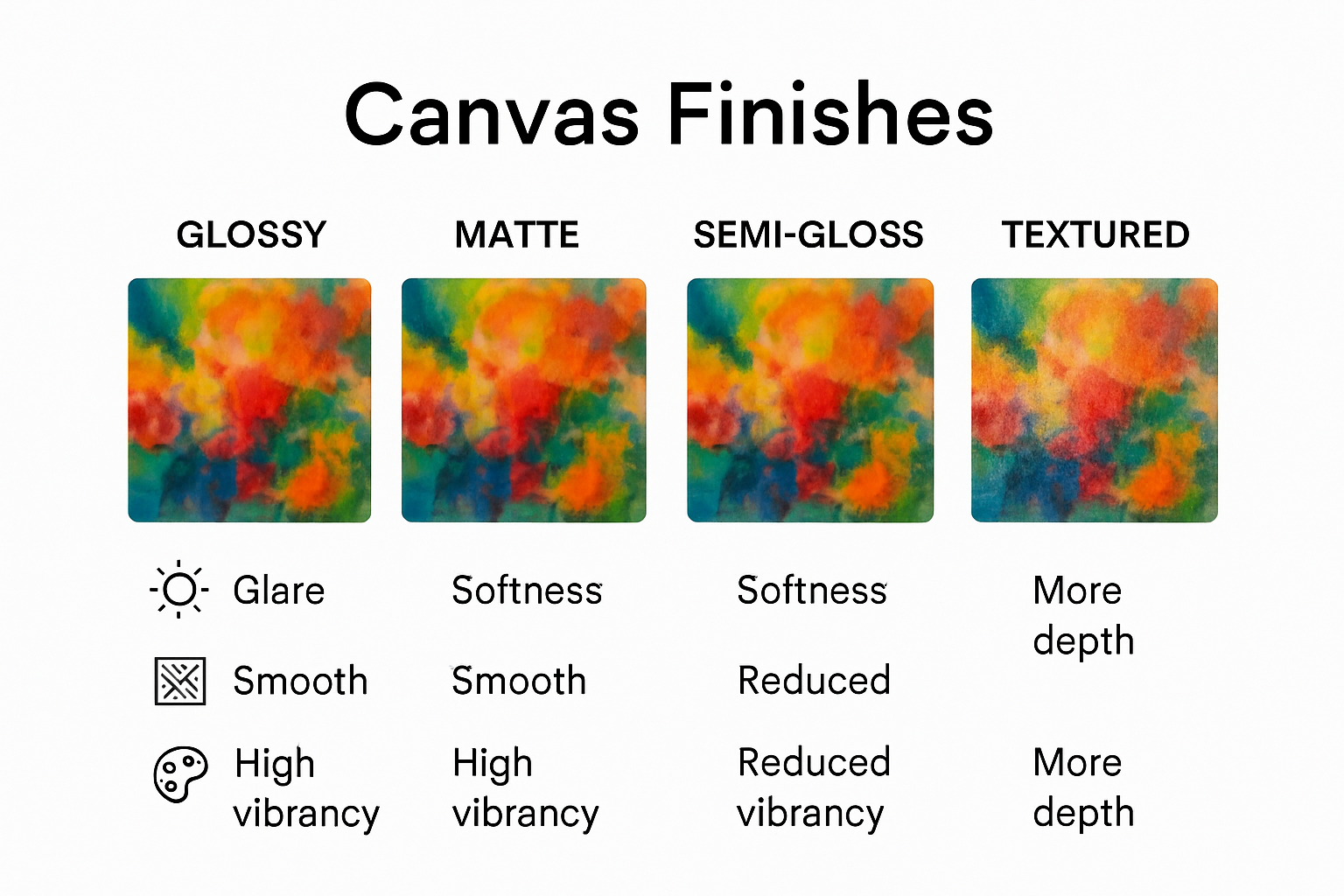
Guide to Different Types of Canvas Finishes for Wall Art

Choosing a canvas finish can feel overwhelming when gallery walls and home decor stores offer so many tempting options. Glossy or matte? Textured or smooth? Most people do not realize that glossy finishes reflect nearly 80 percent more light than matte surfaces which makes them bold but sometimes blinding. The real surprise is this has nothing to do with artistic taste and everything to do with how your room feels once the art is hanging. Where you put your canvas and how you want it to play with light changes the whole experience.
Table of Contents
- Understanding Canvas Finish Options
- Comparing Popular Types of Canvas Finishes
- Choosing the Right Canvas Finish for Your Space
- Tips for Caring for Different Canvas Finishes
Quick Summary
| Takeaway | Explanation |
|---|---|
| Choose the right canvas finish | Selecting an appropriate finish enhances visual appeal and longevity of your artwork. Consider factors like lighting and environment for optimal choices. |
| Glossy finishes enhance vibrancy | Glossy canvas finishes create intense color saturation and reflection, ideal for vibrant artwork. Use strategically to avoid glare in bright rooms. |
| Matte finishes reduce glare | Matte canvas finishes absorb light, making them perfect for delicate artworks. They provide subtle elegance and enhance viewability in varied lighting. |
| Textured finishes add depth | Textured canvas finishes provide a three-dimensional quality, making artworks feel more original. They engage viewers by enhancing tactile experiences. |
| Regular maintenance is essential | Different finishes require tailored care strategies to preserve artwork. Developing a consistent cleaning routine extends the life and beauty of canvas prints. |
Understanding Canvas Finish Options
Canvas finishes transform ordinary wall art into extraordinary visual experiences, offering artists and art collectors unique ways to enhance the aesthetic and durability of their cherished pieces. The right canvas finish can dramatically impact how artwork appears, feels, and interacts with surrounding light and space.
The Science Behind Canvas Surface Treatments
Canvas finishes are more than just aesthetic choices. They represent a complex interplay of material science, artistic intention, and preservation techniques. These surface treatments serve multiple critical functions beyond mere appearance. According to Material Science Research Institute, canvas finishes protect artwork from environmental degradation while simultaneously enhancing visual depth and texture.
The primary types of canvas finishes include glossy, matte, semi-gloss, and textured surfaces. Each finish interacts differently with light, creating unique visual experiences. A glossy finish reflects more light, making colors appear more vibrant and saturated. Conversely, matte finishes absorb light, providing a softer, more subdued presentation that reduces glare and potential reflection issues.
Practical Considerations in Canvas Finish Selection
Selecting the right canvas finish requires understanding both aesthetic preferences and practical considerations. Art Preservation Quarterly suggests that environmental factors play a significant role in determining the most appropriate finish. For instance, artwork displayed in rooms with significant natural light might benefit from a matte or semi-gloss finish to minimize unwanted reflections.
Professional artists and interior designers consider several key factors when choosing canvas finishes:
- Light Interaction: How the finish will reflect or absorb light in the intended display space
- Color Preservation: The finish’s ability to maintain color integrity over time
- Durability: Resistance to environmental factors like humidity and UV exposure
Textured finishes add another dimension to canvas art, creating physical depth that can make prints feel more like original paintings. These finishes use specialized techniques to simulate brushstrokes or add subtle relief, providing a more tactile and engaging viewing experience.

Emerging Trends in Canvas Finish Technology
Recent advancements in surface treatment technologies are expanding artistic possibilities. Innovative techniques now allow for microscopic texturing that can enhance color vibrancy while providing enhanced protection. Some modern canvas finishes incorporate nano-ceramic coatings that offer unprecedented resistance to environmental degradation.
For art enthusiasts looking to dive deeper into preservation techniques, our comprehensive guide on canvas print care offers additional insights into maintaining the quality of your artwork.
Understanding canvas finishes is not just about aesthetics but about creating lasting, resilient art pieces that will continue to inspire and delight viewers for years to come. Whether you prefer the bold statements of glossy finishes or the understated elegance of matte surfaces, the right canvas finish can elevate your artwork from simple decoration to a profound visual experience.
Comparing Popular Types of Canvas Finishes
Selecting the right canvas finish can transform an artwork from ordinary to extraordinary, with each finish offering unique visual and tactile characteristics that dramatically influence the overall aesthetic experience. Professional artists and collectors understand that canvas finishes are far more than simple surface treatments they are critical design choices that impact perception, durability, and emotional resonance.
Glossy Canvas Finishes: Vibrant and Bold
Glossy canvas finishes represent the pinnacle of color intensity and visual drama. According to Art Material Sciences Journal, glossy finishes reflect approximately 80% more light compared to matte surfaces, creating a luminous effect that makes colors appear more saturated and dynamic. These finishes are particularly exceptional for artworks featuring rich, deep color palettes or photographic reproductions that benefit from enhanced color depth.
Key characteristics of glossy canvas finishes include:
- Maximum Color Saturation: Exceptional color vibrancy and depth
- High Light Reflection: Creates a mirror-like sheen
- Contemporary Aesthetic: Ideal for modern and pop art styles
However, glossy finishes come with potential drawbacks. They can create significant glare in rooms with abundant natural or artificial light, potentially obscuring details and creating visual discomfort for viewers. Professional art curators often recommend strategic placement to maximize their visual impact.
Matte Canvas Finishes: Subtle and Sophisticated
Matte canvas finishes offer a sophisticated alternative that prioritizes subtle elegance and visual softness. Artistic Preservation Institute notes that matte finishes absorb light rather than reflect it, creating a more nuanced and contemplative viewing experience. These finishes are particularly well-suited for artwork featuring delicate color gradients, watercolor-style pieces, or intricate details that require minimal visual interference.
Characteristics of matte canvas finishes include:
- Reduced Glare: Minimal light reflection
- Soft Visual Texture: Creates a more subdued artistic presentation
- Enhanced Detail Visibility: Allows intricate elements to shine
Artists frequently select matte finishes for landscapes, abstract compositions, and pieces intended for spaces with variable lighting conditions. The reduced reflectivity ensures that artwork remains visible and engaging from multiple viewing angles.
Textured Canvas Finishes: Adding Dimensional Complexity
Textured canvas finishes represent the most innovative approach to surface treatment, offering a three-dimensional quality that blurs the line between print and original artwork. Modern techniques allow for microscopic surface variations that simulate brushstrokes, creating a tactile experience that engages viewers beyond visual perception.
For those interested in exploring how different canvas finishes can enhance artwork, our comprehensive guide to canvas print selection provides additional insights into making the perfect choice.
The selection of a canvas finish is an intimate artistic decision that requires careful consideration of the artwork’s content, intended display environment, and desired emotional impact. Each finish tells a different story, transforming a simple print into a compelling visual narrative that speaks directly to the viewer’s aesthetic sensibilities.
To help readers easily compare the main types of canvas finishes, the table below summarizes their key visual features, benefits, and potential drawbacks.
| Finish Type | Key Visual Features | Main Benefits | Potential Drawbacks |
|---|---|---|---|
| Glossy | Highly reflective, vibrant color | Intense color, modern feel | Glare, reflections in bright rooms |
| Matte | Soft, non-reflective | Subtle elegance, reduces glare | Colors appear less intense |
| Textured | 3D surface, simulates brushwork | Adds depth, tactile engagement | Can collect dust, needs care |
| Semi-Gloss | Moderate sheen | Balance of vibrancy & reduced glare | Mild reflection may occur |
Choosing the Right Canvas Finish for Your Space
Selecting the perfect canvas finish is a nuanced art form that goes beyond aesthetic preferences. It requires a strategic approach that considers room characteristics, lighting conditions, artwork style, and the emotional atmosphere you want to create. The right canvas finish can transform a space, turning a simple wall into a captivating visual narrative.
Assessing Room Lighting and Environment
Interior Design Research Center emphasizes that lighting plays a critical role in canvas finish selection. Natural and artificial light interact differently with various surface treatments, dramatically altering the artwork’s appearance. Rooms with abundant natural light require careful finish considerations to prevent glare and color distortion.
Key environmental factors to evaluate include:
- Natural Light Exposure: Amount and intensity of sunlight
- Room Orientation: North-facing versus south-facing spaces
- Artificial Lighting: Type and placement of light fixtures
- Wall Color: Background tone and reflectivity
For spaces with intense direct sunlight, matte or semi-gloss finishes can minimize reflections and preserve artwork integrity. Conversely, rooms with softer, diffused lighting might benefit from glossy finishes that enhance color vibrancy.
Matching Finishes to Artistic Styles
The canvas finish should complement and elevate the artwork’s inherent characteristics. According to Contemporary Art Preservation Institute, different artistic styles demand specific surface treatments to maximize visual impact.
- Photographic Prints: Glossy finishes enhance color saturation and detail
- Abstract Art: Textured finishes add dimensional complexity
- Watercolor and Soft Compositions: Matte finishes provide subtle elegance
- Bold Graphic Designs: Semi-gloss finishes offer balanced reflection
Professional art curators recommend treating the canvas finish as an extension of the artwork itself, creating a harmonious visual experience that draws viewers into the piece.
Practical Considerations for Long-Term Display
Beyond aesthetic considerations, durability and maintenance are crucial factors in canvas finish selection. Home Design Quarterly reports that different finishes require varying levels of care and are susceptible to different environmental challenges.
Textured and glossy finishes might collect dust more readily, requiring periodic gentle cleaning. Matte finishes tend to be more forgiving and can maintain their appearance with minimal maintenance. Climate factors such as humidity and temperature fluctuations also impact canvas finish longevity.
For art enthusiasts seeking additional guidance on preserving their canvas artwork, our comprehensive art display guide offers expert insights into creating the perfect display environment.
Ultimately, choosing the right canvas finish is a personal journey that balances technical considerations with emotional resonance. By understanding how different finishes interact with light, complement artistic styles, and withstand environmental challenges, you can transform your space into a curated gallery that reflects your unique aesthetic vision.
Tips for Caring for Different Canvas Finishes
Preserving the beauty and integrity of canvas artwork requires specialized care tailored to specific finish types. Professional art conservators emphasize that each canvas finish demands a unique approach to maintenance, ensuring longevity and visual brilliance for years to come.
Cleaning and Maintenance Strategies
Art Conservation Institute recommends distinct cleaning protocols for different canvas finishes. Understanding the nuanced requirements of each surface treatment is crucial to preventing unintentional damage during routine maintenance.
For glossy canvas finishes:
- Gentle Microfiber Approach: Use soft, lint-free microfiber cloths
- Avoid Liquid Cleaners: Dry dusting is preferred
- Minimal Contact: Light, delicate touches to prevent surface scratching
Matte canvas finishes require a more delicate touch. Preservation Techniques Journal suggests using specialized soft brushes with ultra-soft bristles to remove dust particles without compromising the subtle surface texture. Static-free cleaning tools can help prevent dust accumulation without direct physical contact.
Below is a quick-reference table describing the recommended cleaning techniques by canvas finish type to help preserve your artwork effectively.
| Finish Type | Recommended Cleaning Tools | Special Precautions |
|---|---|---|
| Glossy | Microfiber cloth (dry) | Avoid liquids, minimize handling |
| Matte | Ultra-soft brush, static-free tools | No rubbing or pressure |
| Textured | Compressed air, specialized brushes | Gently clean crevices, don’t use water |
Environmental Protection Techniques
Environmental factors play a critical role in canvas finish preservation. Exposure to direct sunlight, humidity, and temperature fluctuations can significantly impact artwork longevity. Professional art curators recommend strategic placement and protective measures to mitigate potential damage.
Key environmental protection strategies include:
- UV Protection: Use museum-grade glass or protective coatings
- Humidity Control: Maintain consistent room humidity between 45-55%
- Temperature Stability: Avoid extreme temperature variations
- Indirect Light Exposure: Minimize direct sunlight contact
Textured canvas finishes present unique challenges. These intricate surfaces collect dust more readily and require specialized cleaning techniques. Compressed air or specialized art cleaning tools can gently remove debris from surface crevices without causing damage.
Professional Maintenance and Restoration
Periodic professional assessment becomes crucial for maintaining canvas artwork, especially for valuable or historically significant pieces. Art Restoration Quarterly emphasizes the importance of expert evaluation to identify potential preservation issues before they become significant problems.
For art enthusiasts seeking comprehensive guidance, our expert canvas care resource provides in-depth insights into maintaining different canvas finishes.
While routine maintenance might seem overwhelming, developing a consistent care routine can dramatically extend the life and beauty of canvas artwork. Understanding the specific needs of each finish type transforms preservation from a daunting task into an enjoyable aspect of art ownership.
Remember that each canvas finish tells a unique story. By implementing thoughtful care techniques, you protect not just the physical artwork, but the artistic expression and emotional resonance captured within its surface. Proper maintenance ensures that your cherished pieces continue to inspire and delight for generations to come.

Frequently Asked Questions
What are the different types of canvas finishes available for wall art?
Canvas finishes commonly include glossy, matte, semi-gloss, and textured surfaces. Each type interacts differently with light and can dramatically alter the appearance of artwork.
How does a glossy canvas finish affect the artwork’s appearance?
A glossy canvas finish reflects approximately 80% more light, enhancing color saturation and intensity. It creates a vibrant and dynamic visual effect but may cause glare in bright rooms.
Why would I choose a matte canvas finish over a glossy one?
Matte canvas finishes absorb light rather than reflecting it, providing a subtle and elegant presentation. They are ideal for delicate artworks and environments with variable lighting, reducing glare and enhancing detail visibility.
What care strategies are recommended for maintaining textured canvas finishes?
Textured finishes require special cleaning attention due to their 3D surface. It is advisable to use compressed air or specialized brushes to gently remove dust from crevices without causing damage.
Transform Room Ambience with the Ideal Canvas Finish
Are you struggling to find wall art that truly fits your lighting, space, and personal style? The right canvas finish can make all the difference, changing a harsh glare into warmth or making subtle details pop in your room. If you read our guide and realized that the finish you choose affects not just how your art looks but also how your space feels, you’re not alone. The challenge is finding quality canvas prints where every detail from glossy vibrance to matte elegance and rich textures is thoughtfully crafted.
Discover how Marta Ellie’s curated collections effortlessly solve these concerns. Each art piece—from captivating event scenes to serene retreat moments—is expertly produced using high-quality materials and a range of professional finishes to suit your environment. Whether you are looking for bold gloss, refined matte, or inviting texture, our collection like the Art Gallery Opening Night Wall Art offers options that match both your décor goals and technical needs.

Ready to elevate your home or office with artwork tailored to your design preferences? Visit Marta Ellie’s website to browse exclusive pieces. Select by finish, view detailed product images, and purchase directly in just a few clicks. Bring the art studio experience to your wall and let every detail shine. Shop your perfect canvas today before limited editions sell out.
Recommended
- Caring for Canvas Art: Expert Tips for Wall Decor 2025 – Exclusive Canvas Art
- Art Print vs Canvas: Best Choice for Modern Home Decor 2025 – Exclusive Canvas Art
- How to Choose Art for Living Room Walls: 2025 Guide – Exclusive Canvas Art
- Canvas vs Framed Prints: Choosing the Right Art for 2025 – Exclusive Canvas Art